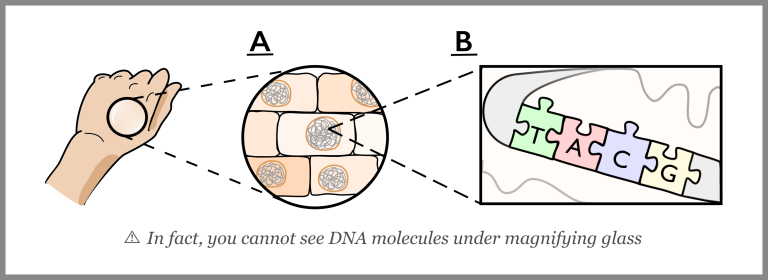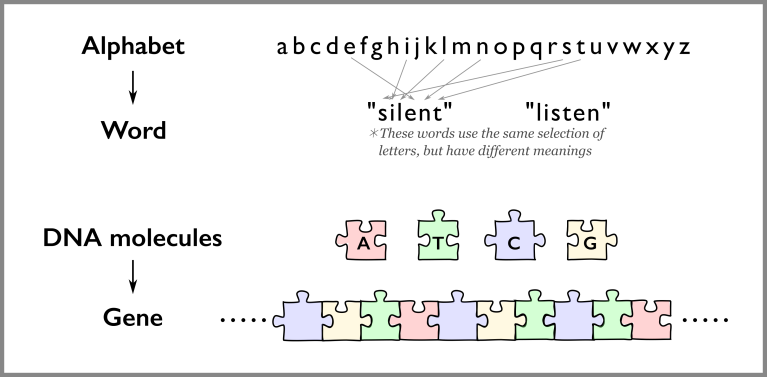Most things about you are written in your genes: from the colour of your eyes, whether you are lactose intolerant, to if you have a higher chance of getting certain diseases. You may have heard of the popular ancestry DNA testing service that tells if you are part Chinese, part Latino. What exactly is a gene? And how is a gene different from DNA?
What is DNA?
Let’s imagine taking a magnifying glass and looking at the back of your hand. If you have enough magnifying power, you will see cells with a nucleus in the middle containing a “ball of yarn” that is DNA (Figure 1A). DNA is short for DeoxyriboNucleic Acid. You can imagine that it looks like a long chain. Every cell in your body has DNA, and the DNA is all identical.
Fun fact: DNA in a single cell is 2 meters long. DNA in all the cells of your body is enough to wrap around the earth over 10 million times!
If we zoom into the DNA more, you will see four different “shapes” that correspond to four different chemical molecules: adenine (A), thymine (T), cytosine (C), guanine (G). (Figure 1B)

What is a gene?
In English, there are 26 letters in the alphabet that are used to form words. The exact order by which letters are grouped together matters: “silent” and “listen” use the same selection of letters but have different meanings.
This is the same for DNA: A, T, C, G are like letters; a sequence of A, T, C, G gives biological meanings. Note that, unlike words that are usually a few letters long, a gene can be a few hundred to thousands of molecules long. (Figure 2) You can learn more in our past Snapshot about genes.

Why do we need to sequence DNA?
It is in the DNA sequence that biological meanings are stored. For example, a mutation (a “genetic typo”) in the gene CACNA1A from a G to an A causes ataxia in people. You can imagine how useful it would be if doctors can read the sequence. Doctors can now use sequencing technology to tell precisely what disease a patient suffers from to prevent misdiagnoses, or even to tell if a person is at risk for different diseases decades before any symptoms are manifested so as to administer preventative treatments.
So, what is DNA sequencing?
The truth is, you cannot see DNA molecules under a magnifying glass (maybe only under a very powerful microscope, but still it is impractical considering how long they are!). Scientists have developed advanced machines that run chemical reactions that work out the sequence of DNA molecules. For further information on how these machines work, check this out: Next Generation Sequencing (NGS) – An Introduction by Applied Biological Materials.
Key Takeaways:
- Genes are like words; DNA is like the letters that make up the words.
- The exact way DNA molecules (A, T, C, G) are ordered is important.
- DNA sequencing allows scientists and doctors to work out the order of A, T, C, G so to understand the biological meaning for disease diagnosis and treatment.
If you would like to learn more about DNA Sequencing, take a look at these resources by Khan Academy and the National Human Genome Research Institute.
Snapshot written by Sophia Leung and edited by Dr. Ray Truant.










